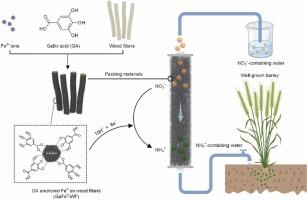Reducing nitrate into ammonium by Fe0-phenolic network with spatiotemporal proton delivery for food sustainability
IF 11.3
1区 环境科学与生态学
Q1 ENGINEERING, ENVIRONMENTAL
引用次数: 0
Abstract
The excessive discharge of nitrate (NO3−) from agricultural and industrial activities disrupts global nitrogen cycles and threatens environmental security, yet conventional remediation methods often fail to reconcile efficient NO3− removal with sustainable resource recovery. Herein, we design a Fe0-phenolic network anchored on wood fibers (GaFe0-WF) to convert NO3− into agriculturally valuable ammonium (NH4+) in fixed-bed column. For the GaFe0-WF, the natural polyphenol is introduced to stabilize zero-valent iron (Fe0) nanoparticles on the surface of residual wood fibers, and spatiotemporally control H+ ions release for driving 8-electron reduction of NO3− into NH4+. Meanwhile, the hierarchical architecture of wood fiber ensures efficient mass transfer. Thus, the GaFe0-WF achieves complete NO3−-N removal (concentration ≤10 mg L–1) with high NH4+-N selectivity (>70 %), outperforming traditional nanoscale Fe0 by suppressing intermediates formation. The removal performance for real-world water samples from the Yangtze River, Jialing River, Minjiang River, and Jinsha River confirms its potential in large scale processing systems. Moreover, barley irrigated with NH4+-containing water reduced by GaFe0-WF exhibits enhanced growth. This work advances sustainable development by synergizing wastewater transformation with fertilizer production, offering a critical closed-loop nutrient management for sustainable agroecosystems.

时空质子传递的fe0 -酚网络将硝酸盐还原成铵对食物可持续性的影响
农业和工业活动中硝酸盐(NO3−)的过量排放破坏了全球氮循环并威胁环境安全,然而传统的修复方法往往无法协调有效的NO3−去除和可持续的资源回收。在此,我们设计了一个固定在木纤维上的fe0 -酚醛网络(GaFe0-WF),将NO3−转化为农业上有价值的铵(NH4+)。在GaFe0-WF中,引入天然多酚来稳定残木纤维表面的零价铁(Fe0)纳米颗粒,并在时空上控制H+离子的释放,驱动NO3 - 8电子还原成NH4+。同时,木纤维的分层结构保证了高效的传质。因此,GaFe0-WF实现了NO3−-N的完全去除(浓度≤10 mg L-1),具有高NH4+-N选择性(>70 %),通过抑制中间体的形成优于传统的纳米级Fe0。对长江、嘉陵江、岷江和金沙江实际水样的去除效果证实了其在大规模处理系统中的潜力。此外,经GaFe0-WF还原性含NH4+水灌溉后,大麦的生长得到了促进。这项工作通过将废水转化与肥料生产协同起来促进可持续发展,为可持续农业生态系统提供关键的闭环养分管理。
本文章由计算机程序翻译,如有差异,请以英文原文为准。
求助全文
约1分钟内获得全文
求助全文
来源期刊

Journal of Hazardous Materials
工程技术-工程:环境
CiteScore
25.40
自引率
5.90%
发文量
3059
审稿时长
58 days
期刊介绍:
The Journal of Hazardous Materials serves as a global platform for promoting cutting-edge research in the field of Environmental Science and Engineering. Our publication features a wide range of articles, including full-length research papers, review articles, and perspectives, with the aim of enhancing our understanding of the dangers and risks associated with various materials concerning public health and the environment. It is important to note that the term "environmental contaminants" refers specifically to substances that pose hazardous effects through contamination, while excluding those that do not have such impacts on the environment or human health. Moreover, we emphasize the distinction between wastes and hazardous materials in order to provide further clarity on the scope of the journal. We have a keen interest in exploring specific compounds and microbial agents that have adverse effects on the environment.
 求助内容:
求助内容: 应助结果提醒方式:
应助结果提醒方式:


